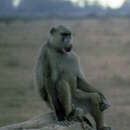en
names in breadcrumbs


Hamadryas baboons (Papio hamadryas) are big fluffy primates with body lengths of up to 75 cm, tail lengths of 55 cm, and a weight between 12 and 21 kg. Like all other baboons, they are sexually dimorphic. Not only are males almost twice the size of females, but they also have silver/grey manes and long shoulder capes, while females have brown coats and no manes. Both male and female hamadryas baboons have pink faces and pink bums.
These baboons can be found in north-east Africa up to Saudi Arabia and Yemen, but mainly occur in Ethiopia, in semi-desert, savannah, short grass plains or rocky areas, and live at altitudes of up to 2600 meters, never too far from a water source.
Like other baboons, hamadryas are omnivorous and feed on a variety of food including fruits, flowers, leaves and small vertebrates, but their main sources come from grasses, tubers, roots and shoots.
Hamadryas baboons have a complicated four-tier social system unlike other baboons. Males generally stay with their natal troop, whereas females migrate to other troops. Males form harems and ‘own’ between two and eleven females, with the females having a hierarchy system within these harems. During the day, two or three groups will come together in foraging groups, known as clans, the males tending to be genetically related. Clans come together to form larger bands, and these bands then merge at night to form a troop of up to 750 individuals to sleep on outcropping rocks. Males will forcefully try to steal females from other bands, but not from their own clans.
A single, black offspring is born after a gestation period of about 170 days, and are dependent on their mothers for the first couple of months, until being weaned at 6 months old. They become independent at 2 years of age and reach sexual maturity at 4 to 6 years of age.
In ancient Egyptian times, the hamadryas baboon was considered a sacred animal and admired for its intelligence, hence they are also called ‘sacred baboon’.
For more information on MammalMAP, visit the MammalMAPvirtual museumorblog.